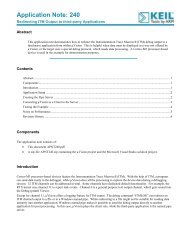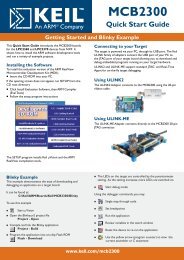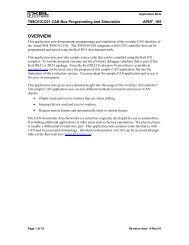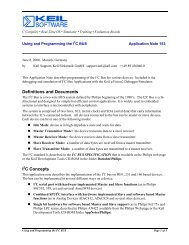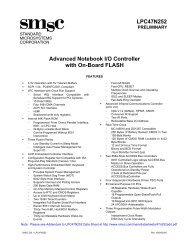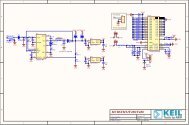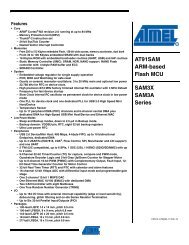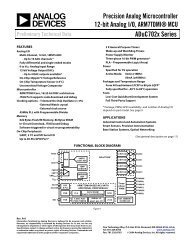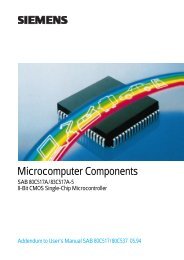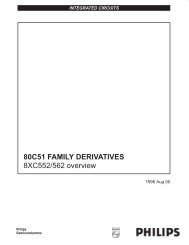You also want an ePaper? Increase the reach of your titles
YUMPU automatically turns print PDFs into web optimized ePapers that Google loves.
Expanded RAM<br />
(XRAM)<br />
Figure 7. Internal and External <strong>Data</strong> Memory Address<br />
4289A–8051–09/03<br />
0FFh to 6FFh 0FFh<br />
00<br />
<strong>AT89C51ID2</strong><br />
The <strong>AT89C51ID2</strong> provides additional Bytes of random access memory (RAM) space for<br />
increased data parameter handling and high level language usage.<br />
<strong>AT89C51ID2</strong> devices have expanded RAM in external data space configurable up to<br />
1792bytes (see Table 23.).<br />
The <strong>AT89C51ID2</strong> has internal data memory that is mapped into four separate<br />
segments.<br />
The four segments are:<br />
1. The Lower 128 bytes of RAM (addresses 00h to 7Fh) are directly and indirectly<br />
addressable.<br />
2. The Upper 128 bytes of RAM (addresses 80h to FFh) are indirectly addressable<br />
only.<br />
3. The Special Function Registers, SFRs, (addresses 80h to FFh) are directly<br />
addressable only.<br />
4. The expanded RAM bytes are indirectly accessed by MOVX instructions, and<br />
with the EXTRAM bit cleared in the AUXR register (see Table 23).<br />
The lower 128 bytes can be accessed by either direct or indirect addressing. The Upper<br />
128 bytes can be accessed by indirect addressing only. The Upper 128 bytes occupy<br />
the same address space as the SFR. That means they have the same address, but are<br />
physically separate from SFR space.<br />
XRAM<br />
Upper<br />
128 bytes<br />
Internal<br />
Ram<br />
indirect accesses<br />
80h 80h<br />
7Fh<br />
00<br />
Lower<br />
128 bytes<br />
Internal<br />
Ram<br />
direct or indirect<br />
accesses<br />
0FFh<br />
Special<br />
Function<br />
Register<br />
direct accesses<br />
0FFFFh<br />
00FFh up to 06FFh<br />
0000<br />
External<br />
<strong>Data</strong><br />
Memory<br />
When an instruction accesses an internal location above address 7Fh, the CPU knows<br />
whether the access is to the upper 128 bytes of data RAM or to SFR space by the<br />
addressing mode used in the instruction.<br />
Instructions that use direct addressing access SFR space. For example: MOV<br />
0A0H, # data, accesses the SFR at location 0A0h (which is P2).<br />
Instructions that use indirect addressing access the Upper 128 bytes of data RAM.<br />
For example: MOV @R0, # data where R0 contains 0A0h, accesses the data byte<br />
at address 0A0h, rather than P2 (whose address is 0A0h).<br />
The XRAM bytes can be accessed by indirect addressing, with EXTRAM bit cleared<br />
and MOVX instructions. This part of memory which is physically located on-chip,<br />
logically occupies the first bytes of external data memory. The bits XRS0 and XRS1<br />
are used to hide a part of the available XRAM as explained in Table 23. This can be<br />
29



